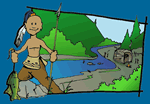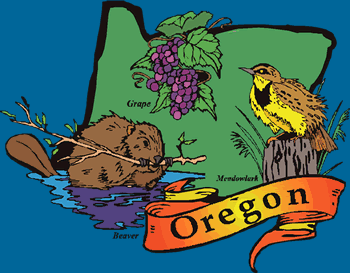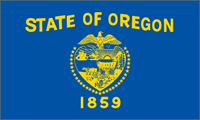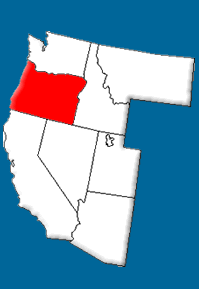


Geography and Landforms:
Oregon is bordered by Washington on the north and California and Nevada on the south. On the east, Oregon is bordered by Idaho and on the west, the state is bordered by the Pacific Ocean.
|
 History:
Spanish and British sailors exploring the Pacific coast may have been the first Europeans to sight Oregon during the fourteenth and fifteenth centuries. Sir Francis Drake of England sailed along the coast in 1579, and may have come as far north as Oregon. These explorations continued through the eighteenth century as both countries sought to claim more territory for their home countries.
|
 Economy:
Oregon is the leading provider of lumber in the United States; about one-tenth of the nation's timber can be found in the state. There are nearly 31 million acres of forest land (almost half the state), and although much of this area is protected from logging for environmental reasons, the state produces more than 5 billion board feet per year. Other industries connected to timber include paper and paper items, printing and publishing.
|
 First Inhabitants:
Archaeologists believe the first humans to come to the area now known as Oregon were part of a group that had arrived in the Northwest from Mongolia using a land bridge between Siberia and Alaska about thirteen thousand years ago. Native Americans who lived in this area created pictographs on canyon walls, and they have legends about how Oregon was created. The earliest groups lived by fishing and hunting large game. Groups living along the lower Columbia River lived in large multi-family long houses. Other groups living further up the Columbia tended to live in smaller groups and be more nomadic. These people fished for salmon on the Willamette River, and in the spring and summer, thousands gathered to harvest the Chinook salmon and trade with one another.
|
Books Related To OregonB is for Beaver: An Oregon Alphabet - Roland Smith The Barn - Avi Bat 6 - Virginia Euwer Wolff The Devil in Ol' Rosie - Louise Moeri Emily's Runaway Imagination - Beverly Cleary Escaping the Giant Wave - Peg Kehret Nora and the Texas Terror - Judy Cox Operation Clean Sweep - Darleen Bailey Beard A Piece of the Sky - David Patneaude Rachel's Journal: The Story of a Pioneer Girl - Marissa Moss |
Famous Citizens:
|
| Capital: | Salem |
| Entered Union: | February 14, 1859 |
| Population: | 3,970,239 |
| Area | 98,381 |
| Bird | Western Meadowlark |
| Flower | Oregon Grape |
| Nickname: | Beaver State |
| Governor | Kate Brown |
Places to Visit in Oregon: (Click the links to learn more.)
|



